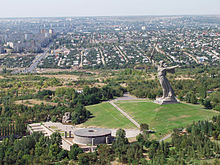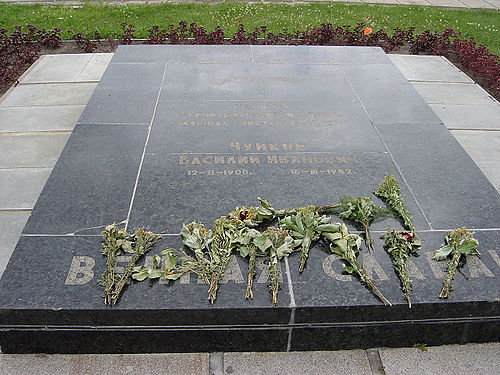- Mamayev Kurgan
-
Mamayev Kurgan (Russian: Мамаев Курган) is a dominant height overlooking the city of Volgograd (formerly Stalingrad) in Southern Russia. The name in Russian means "tumulus of Mamai".[1]
The original Mamayev Kurgan was a Tartar burial mound 102 metres high. The current formation is dominated by a memorial complex commemorating the Battle of Stalingrad (August 1942 to February 1943). The battle was a decisive Soviet victory over Axis forces on the Eastern front of World War II and arguably the bloodiest battle in human history.[2] At the time of its installation in 1967 the statue named The Motherland Calls formed the largest free-standing sculpture in the world.[3]
Contents
Battle
Main article: Battle of StalingradWhen forces of the German 6th Army launched their attack against the city centre of Stalingrad on 13 September 1942, Mamayev Kurgan (appearing in military maps as "Height 102.0") saw particularly fierce fighting between the German attackers and the defending soldiers of the Soviet 62nd Army. Control of the hill became vitally important, as it offered control over the city. To defend it, the Soviets had built strong defensive lines on the slopes of the hill, composed of trenches, barbed-wire and minefields. The Germans pushed forward against the hill, taking heavy casualties. When they finally captured the hill, they started firing on the city centre, as well as on the railway station Stalingrad-1 under the hill. They captured the railway station on 14 September 1942.
On the same day, the Soviet 13th Guards Rifle Division commanded by Alexander Rodimtsev arrived in the city from the east side of the river Volga under heavy German artillery fire. The division's 10,000 men immediately rushed into the battle. On 16 September they recaptured Mamayev Kurgan and kept fighting for the railway station, taking heavy losses. By the following day, almost all of them had died. The Soviets kept reinforcing their units in the city as fast as they could. The Germans assaulted up to twelve times a day, and the Soviets would respond with fierce counter-attacks.
The hill changed hands several times. By 27 September, the Germans again captured half of Mamayev Kurgan. The Soviets held their own positions on the slopes of the hill, as the 284th Rifle Division defended the key stronghold. The defenders held out until 26 January 1943, when the Soviet winter offensive relieved them, trapping and destroying the German forces inside Stalingrad.
When the battle ended, the soil on the hill had been so thoroughly churned by shellfire and mixed with metal fragments that it contained between 500 and 1,250 splinters of metal per square meter. The earth on the hill had remained black in the winter, as the snow kept melting in the many fires and explosions. In the following spring the hill would still remain black, as no grass grew on its scorched soil. The hill's formerly steep slopes had become flattened in months of intense shelling and bombardment. Even today, it is possible to find fragments of bone and metal still buried deep throughout the hill.
Memorial complex
After the war, the Soviet authorities commissioned the enormous Mamayev Kurgan memorial complex. Vasily Chuikov, who led Soviet forces at Stalingrad, lies buried at Mamayev Kurgan, the first Marshal of the Soviet Union to be buried outside Moscow. Soviet sniper Vasily Zaytsev was also reburied there in 2006.
The monumental memorial was constructed between 1959 and 1967, and is crowned by a huge allegorical statue of the Motherland on the top of the hill. The monument, designed by Yevgeny Vuchetich, has the full name "The Motherland Calls!" (Russian: Родина-мать зовёт! Rodina Mat Zovyot!). It consists of a concrete sculpture, 52 metres tall, and 82 metres from the feet to the tip of the 27-metre sword, dominating the skyline of the city of Stalingrad (later renamed Volgograd).
The construction uses concrete, except for the stainless-steel blade of the sword. The statue is held on its plinth solely by its own weight. The statue is evocative of classical Greek representations of Nike, in particular the flowing drapery, similar to that of the Nike of Samothrace.
Structural stability
In May 2009 it was reported that rising water levels had caused the monument's foundations to subside and that the statue was leaning to such a degree (by around 20 cm (8 inches)[4]) it was in danger of collapse.
Notes
- ^ Mamai commanded the Tatar Golden Horde in the 1370s — no historical evidence exists of his burial on the site.
- ^ Roberts, Geoffrey (2006). Stalin's Wars. Yale University Press. p. 154. ISBN 9780300112047. http://books.google.com/?id=5GCFUqBRZ-QC&pg=PA154&dq=.
- ^ Antill, Peter, Stalingrad 1942, Osprey Publishing 2007, ISBN 1846030285.
- ^ Galpin, Richard (8 May 2009). "Russia's massive leaning statue". BBC News. http://news.bbc.co.uk/1/hi/world/europe/8040471.stm.
External links
- Mamayev Hill museum in Volgograd, official homepage (in Russian, English, German).
- Gigapixel panoramas, created on 9 May 2005 for Google Earth, 60 years after the end of the war in Russia
- Iconicarchive photo gallery
See also
Coordinates: 48°44′33″N 44°32′13″E / 48.7425°N 44.53694°E
Airfields · Axis order of battle · Red Army order of battle · Bombing of Stalingrad in World War II · German commanders · German units Operations Formations  4th Panzer · 6th
4th Panzer · 6th
 2nd
2nd
 8th
8th
 3rd · 4th
3rd · 4th
 1st Guards · 2nd Guards · 3rd Guards · 21st · 51st · 62nd · 64th · 65th
1st Guards · 2nd Guards · 3rd Guards · 21st · 51st · 62nd · 64th · 65th XIV Panzer · XL Panzer · XLVIII Panzer · IV · VIII · XI · LI · 8th Air
XIV Panzer · XL Panzer · XLVIII Panzer · IV · VIII · XI · LI · 8th Air
 1st Tank · 4th Tank · 13th Tank · 16th Tank · 24th Tank · 26th Tank · 4th Mechanised · 13th Mechanised · 3rd Guards Cavalry · 4th Cavalry · 8th Cavalry
1st Tank · 4th Tank · 13th Tank · 16th Tank · 24th Tank · 26th Tank · 4th Mechanised · 13th Mechanised · 3rd Guards Cavalry · 4th Cavalry · 8th Cavalry 6th Panzer · 14th Panzer · 16th Panzer · 17th Panzer · 22nd Panzer, · 24th Panzer · 3rd Motorised Infantry · 29th Motorised Infantry · 60th Motorised Infantry · 5th Infantry · 44th Infantry · 71st Infantry · 76th Infantry · 79th Infantry · 94th Infantry · 100th Infantry · 113th Infantry · 295th Infantry · 297th Infantry · 305th Infantry · 371st Infantry · 376th Infantry · 384th Infantry · 389th Infantry
6th Panzer · 14th Panzer · 16th Panzer · 17th Panzer · 22nd Panzer, · 24th Panzer · 3rd Motorised Infantry · 29th Motorised Infantry · 60th Motorised Infantry · 5th Infantry · 44th Infantry · 71st Infantry · 76th Infantry · 79th Infantry · 94th Infantry · 100th Infantry · 113th Infantry · 295th Infantry · 297th Infantry · 305th Infantry · 371st Infantry · 376th Infantry · 384th Infantry · 389th Infantry
 13th Guards Rifle · 15th Guards Rifle · 33rd Guards Rifle · 35th Guards Rifle · 36th Guards Rifle · 37th Guards Rifle · 39th Guards Rifle · 38th Rifle · 45th Rifle · 62nd Rifle · 64th Rifle · 91st Rifle · 93rd Rifle · 95th Rifle · 112th Rifle · 138th Rifle · 157th Rifle · 169th Rifle · 173rd Rifle · 181st Rifle · 193rd Rifle · 196th Rifle · 204th Rifle · 214th Rifle · 221st Rifle · 248th Rifle · 284th Rifle · 302nd Rifle · 308th Rifle · 422nd Rifle · 685th Rifle · 414th Anti-Tank · 149th Artillery · 60th Cavalry · 81st Cavalry
13th Guards Rifle · 15th Guards Rifle · 33rd Guards Rifle · 35th Guards Rifle · 36th Guards Rifle · 37th Guards Rifle · 39th Guards Rifle · 38th Rifle · 45th Rifle · 62nd Rifle · 64th Rifle · 91st Rifle · 93rd Rifle · 95th Rifle · 112th Rifle · 138th Rifle · 157th Rifle · 169th Rifle · 173rd Rifle · 181st Rifle · 193rd Rifle · 196th Rifle · 204th Rifle · 214th Rifle · 221st Rifle · 248th Rifle · 284th Rifle · 302nd Rifle · 308th Rifle · 422nd Rifle · 685th Rifle · 414th Anti-Tank · 149th Artillery · 60th Cavalry · 81st CavalryNotable
participants Adolf Hitler · Alexander Edler von Daniels · Wilhelm Hoffman · Hermann Hoth · Hans-Valentin Hube · Erwin König · Erich von Manstein · Friedrich Paulus · Wolfram von Richthofen · Arthur Schmidt · Walther von Seydlitz-Kurzbach · Karl Strecker
Adolf Hitler · Alexander Edler von Daniels · Wilhelm Hoffman · Hermann Hoth · Hans-Valentin Hube · Erwin König · Erich von Manstein · Friedrich Paulus · Wolfram von Richthofen · Arthur Schmidt · Walther von Seydlitz-Kurzbach · Karl Strecker
 Viktor Pavičić
Viktor Pavičić
 Italo Gariboldi
Italo Gariboldi
 Gusztáv Vitéz Jány
Gusztáv Vitéz Jány
 Constantin Constantinescu-Claps · Petre Dumitrescu · Mihail Lascăr
Constantin Constantinescu-Claps · Petre Dumitrescu · Mihail Lascăr
 Joseph Stalin · Azi Aslanov · Vasily Badanov · Vasily Chuikov · Nikolay Dyatlenko · Sasha Fillipov · Peter Gitelman · Vasily Grossman · Nikita Khrushchev · Dmitry Lelyushenko · Rodion Malinovsky · Yakov Pavlov · Alexander Rodimtsev · Konstantin Rokossovsky · Alexander Shcherbakov · Semyon Timoshenko · Aleksandr Vasilevsky · Nikolay Voronov · Erich Weinert · Andrei Yeremenko · Vasily Zaytsev · Georgy Zhukov
Joseph Stalin · Azi Aslanov · Vasily Badanov · Vasily Chuikov · Nikolay Dyatlenko · Sasha Fillipov · Peter Gitelman · Vasily Grossman · Nikita Khrushchev · Dmitry Lelyushenko · Rodion Malinovsky · Yakov Pavlov · Alexander Rodimtsev · Konstantin Rokossovsky · Alexander Shcherbakov · Semyon Timoshenko · Aleksandr Vasilevsky · Nikolay Voronov · Erich Weinert · Andrei Yeremenko · Vasily Zaytsev · Georgy ZhukovLocations Barmaley Fountain · Barrikady works · Grain silo · Gumrak · Kalach · Mamayev Kurgan · Pavlov's House · Pitomnik Airfield · Red October Steel Factory · River Don · River Volga · Tatsinskaya Airfield · Tsaritsa gorge · Volgograd Tractor FactoryIn memoriam The Motherland Calls · Stalingrad Madonna · Sword of Stalingrad · Battle of Stalingrad in popular cultureSee also: Battle of the Caucasus · Battle of Kursk · Battle of Nikolayevka · Case Blue · Operation Barbarossa · Second Battle of Kharkov · Third Battle of Kharkov · Volgograd Categories:- Battle of Stalingrad
- Cemeteries in Russia
- Commemorative mounds
- Hills of Russia
- Kurgans
- Soviet military memorials and cemeteries
- Volgograd
- World War II memorials in Russia
Wikimedia Foundation. 2010.




